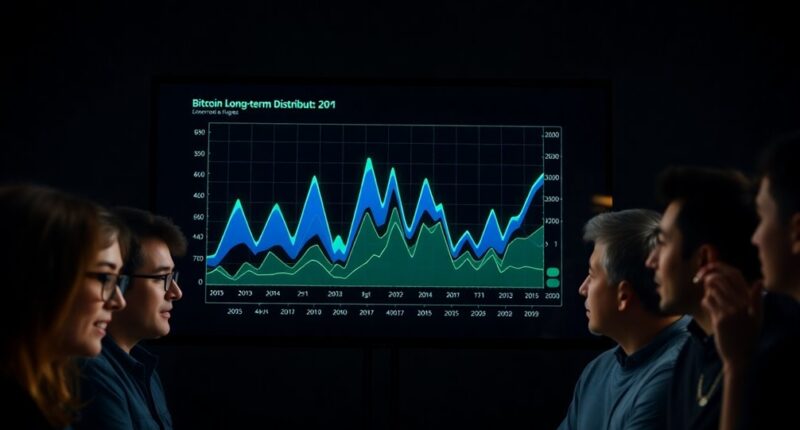Bitcoin's long-term holder distribution is peaking, signaling a strong bullish market ahead. With over 90% of BTC supply in profit, it's clear that long-term holders possess confidence in future price movements. They've accumulated over $22 billion worth of Bitcoin in just the last three months, showcasing their resilience. This accumulation trend suggests that long-term holders typically resist short-term volatility, enhancing market stability. As you consider your own investment strategies, understanding these trends can be crucial. There's much more to explore about how these dynamics can influence your investment decisions.
Key Takeaways
- Over 90% of Bitcoin supply is currently in profit, indicating strong sentiment among long-term holders and signaling potential for a bull market.
- Historical trends show that increased long-term holder distribution often correlates with price surges, reflecting market confidence.
- Long-term holders have accumulated over $22 billion in Bitcoin in the past three months, showcasing strategic behavior amid market fluctuations.
- High accumulation rates, with an Accumulation Trend Score at max value, suggest renewed confidence among investors for a bullish outlook.
- The resilience of long-term holders against market volatility contributes to stability and influences broader market trends, supporting bullish sentiments.
Long-Term Holder Significance

As Bitcoin continues to evolve, understanding the significance of long-term holders becomes crucial. These investors are gradually accumulating Bitcoin, reflecting rising optimism about its future potential. With over 90% of BTC supply currently in profit, positive sentiment is evident, supported by a Fear & Greed Index firmly in the bullish range. Additionally, the slight increase in long-term holder supply indicates renewed confidence among seasoned investors.
Historically, long-term holders have weathered market volatility, viewing Bitcoin as a long-term investment. Their commitment can help buffer against price swings, reinforcing market stability.
Market Dynamics and Holder Behavior

While market dynamics constantly shift, understanding holder behavior is essential for navigating the Bitcoin landscape. Short-term holders are displaying renewed optimism, showing a willingness to take risks by expanding their buying positions. Recently, their realized capitalization surged by $6 billion, reflecting a positive shift in market sentiment as we move into Q4. This increase marks a notable shift from short-term holder sentiment being at -$17 billion to -$11 billion in a week.
In contrast, long-term holders are typically stabilizing forces, accumulating coins to reduce volatility and maintain price stability. Positive vaulting rates indicate confidence in Bitcoin's future value.
As these dynamics unfold, observing how both short-term and long-term holders react can provide valuable insights into market trends and potential price movements. Stay alert to these shifts to better inform your investment strategy.
Holder Accumulation Over Time

Understanding how holder accumulation evolves over time reveals significant insights into market behavior.
Long-term holders typically accumulate Bitcoin during market downturns, seizing opportunities when prices are low. Recently, you've witnessed a remarkable trend, with over $22 billion worth of BTC accumulated in just three months. This accumulation has contributed to a shift in LTH behavior, signaling renewed confidence among long-term holders. As the Accumulation Trend Score (ATS) hits its max value of 1.0, it indicates a strong shift back toward accumulation.
With supply dynamics shifting and long-term holders showing resilience, it's clear that their strategic approach continues to influence the market, reflecting a preference for holding during weak trends while waiting for better prices ahead.
Pros and Cons of Holding

When you consider holding Bitcoin long-term, it's essential to weigh both the benefits and drawbacks that come with this strategy.
On the plus side, you could see substantial gains; Bitcoin's historical returns are impressive. You'll also benefit from reduced transaction costs, as fewer trades mean saving on fees. Plus, holding Bitcoin can diversify your portfolio and may qualify you for lower long-term capital gains tax rates. Additionally, employing a buy and hold strategy can simplify your investment decisions by minimizing the need for constant trading.
However, you'll face exposure to market volatility, risking significant paper losses during downturns. There's also opportunity cost; your capital might miss out on short-term profits.
Additionally, long-term holding can be psychologically stressful and limit liquidity, potentially making it hard to access cash when you need it.
HODL Versus Trading Strategies

Choosing between HODLing and trading strategies can significantly impact your investment experience and outcomes.
HODLing is ideal if you prefer a hands-off approach, allowing you to buy and hold cryptocurrencies for the long term. This strategy minimizes stress and trading fees while letting you benefit from market appreciation over time. By adopting a long-term investment strategy, you can focus on the fundamental value of your assets rather than short-term price fluctuations.
On the other hand, trading can deliver quick returns if you're comfortable with market fluctuations. It requires active management and emotional discipline, as you'll need to adapt to changing conditions.
Ultimately, your choice should reflect your risk tolerance, investment horizon, and personal style. Understanding these strategies helps you align your approach with your financial goals, leading to more informed decisions in the crypto space.
Market Volatility Impacts Holders

As market volatility continues to shape the cryptocurrency landscape, holders of Bitcoin face both challenges and opportunities. Regulatory changes can significantly impact prices, with positive announcements boosting confidence and negative news prompting sell-offs. Staying informed about these trends is crucial for navigating volatility effectively. Additionally, the fixed supply of Bitcoin, capped at 21 million units, means that any increase in demand can lead to significant price movements.
Long-term holders, or "HODLers," provide stability by holding their investments despite fluctuations, reducing the supply available for trading. However, short-term traders, driven by market trends, can amplify volatility through rapid buying and selling.
Additionally, the influence of large investors, or whales, can lead to substantial price swings, making it essential for you to monitor their activities. Ultimately, your approach to volatility will determine your success in this dynamic market.
Increased Institutional Investment

The surge in institutional investment is reshaping the Bitcoin landscape, creating new opportunities for both established players and newcomers.
You'll notice a growing demand as $36 billion flows into spot Bitcoin ETFs, alongside major corporate players like MicroStrategy amassing significant Bitcoin holdings.
With regulatory clarity on the horizon, institutional adoption seems poised to accelerate. Imagine the U.S. potentially including Bitcoin in its strategic reserves, which could legitimize its status even further.
As institutional sentiment shifts, the market cap could skyrocket to $4.5 trillion by 2025. Analysts project Bitcoin price range for 2025: $125,000 to $350,000 is a reflection of the growing confidence in the cryptocurrency's future.
Enhanced operational efficiency through AI integration and tokenization of assets is also attracting more investors.
All these factors combined could dramatically impact Bitcoin's price dynamics and solidify its market presence.
Diversify Long-Term Crypto Holdings

With institutional investment reshaping the Bitcoin landscape, it's important to think about diversifying your long-term crypto holdings.
Start by distributing your investments among different cryptocurrencies, balancing risk and reward. A conservative portfolio might allocate 60% to Bitcoin, while a balanced one could split it 40% between Bitcoin and altcoins.
Don't forget sector diversification; explore opportunities in DeFi, NFTs, and layer 1 protocols.
Additionally, consider market cap diversification by investing in large, mid, and small-cap cryptocurrencies.
Stay updated on emerging technologies like dApps and monitor their impact. High volatility in the cryptocurrency market can significantly affect asset prices, emphasizing the need for careful risk management.
Regularly rebalance your portfolio to maintain your desired allocation and manage risks effectively.
This strategic approach can enhance your long-term investment potential.
Frequently Asked Questions
How Can I Identify Long-Term Holders in the Market?
To identify long-term holders in the market, you'll want to look for entities that have held Bitcoin for at least 155 days.
Analyze wallet activity and unspent transaction outputs (UTXOs) to determine their spending patterns.
You can also track on-chain metrics to gauge the amount of Bitcoin held by these investors.
What Tools Can Help Track Bitcoin Holder Distribution?
Imagine you're a treasure hunter, sifting through the sands for hidden gems.
To track Bitcoin holder distribution, you can use tools like Entity-Adjustment Clustering Algorithms to group addresses, or Bitquery's APIs for real-time holder data.
Glassnode offers insights on supply breakdowns, while Bitcoin Magazine Pro Charts can show long-term holder trends.
Each tool uncovers a layer of the Bitcoin landscape, helping you navigate the depths of this digital treasure.
Are There Any Risks in Being a Long-Term Holder?
Yes, there are risks in being a long-term holder.
You'll face market volatility, as Bitcoin's price can swing dramatically, potentially leading to losses.
You might also encounter supply dynamics, where distribution peaks signal market shifts.
Short-term holder behavior can pressure prices, affecting your investment confidence.
Lastly, while the current market seems strong, any correction risks could impact your holdings, so staying informed and ready for changes is crucial.
How Do Macroeconomic Factors Influence Long-Term Holder Sentiment?
Macroeconomic factors significantly influence your long-term holder sentiment.
Rising inflation expectations can make Bitcoin more appealing as a hedge, boosting your confidence in holding.
Likewise, liquidity metrics, such as money supply changes, directly affect Bitcoin's price, impacting your investment decisions.
If interest rates rise or monetary policy tightens, you might feel less secure about your holdings.
Staying aware of these factors helps you navigate the market and make informed choices.
Can Long-Term Holders Influence Bitcoin's Price Significantly?
Imagine a scenario where a long-term holder, like you, decides to sell a significant portion of your Bitcoin during a price surge.
Your decision would likely trigger a ripple effect, influencing market sentiment and prompting short-term holders to react.
This demonstrates how long-term holders can significantly impact Bitcoin's price.
Conclusion
In this evolving landscape, recognizing the importance of long-term holders can shape your investment strategy. By understanding market dynamics, embracing the power of accumulation, and weighing the pros and cons of holding versus trading, you can navigate the volatility with confidence. As institutional investments rise and diversification becomes key, you're not just a passive observer; you're an active participant. So, whether you choose to HODL or trade, make informed decisions that align with your goals.









